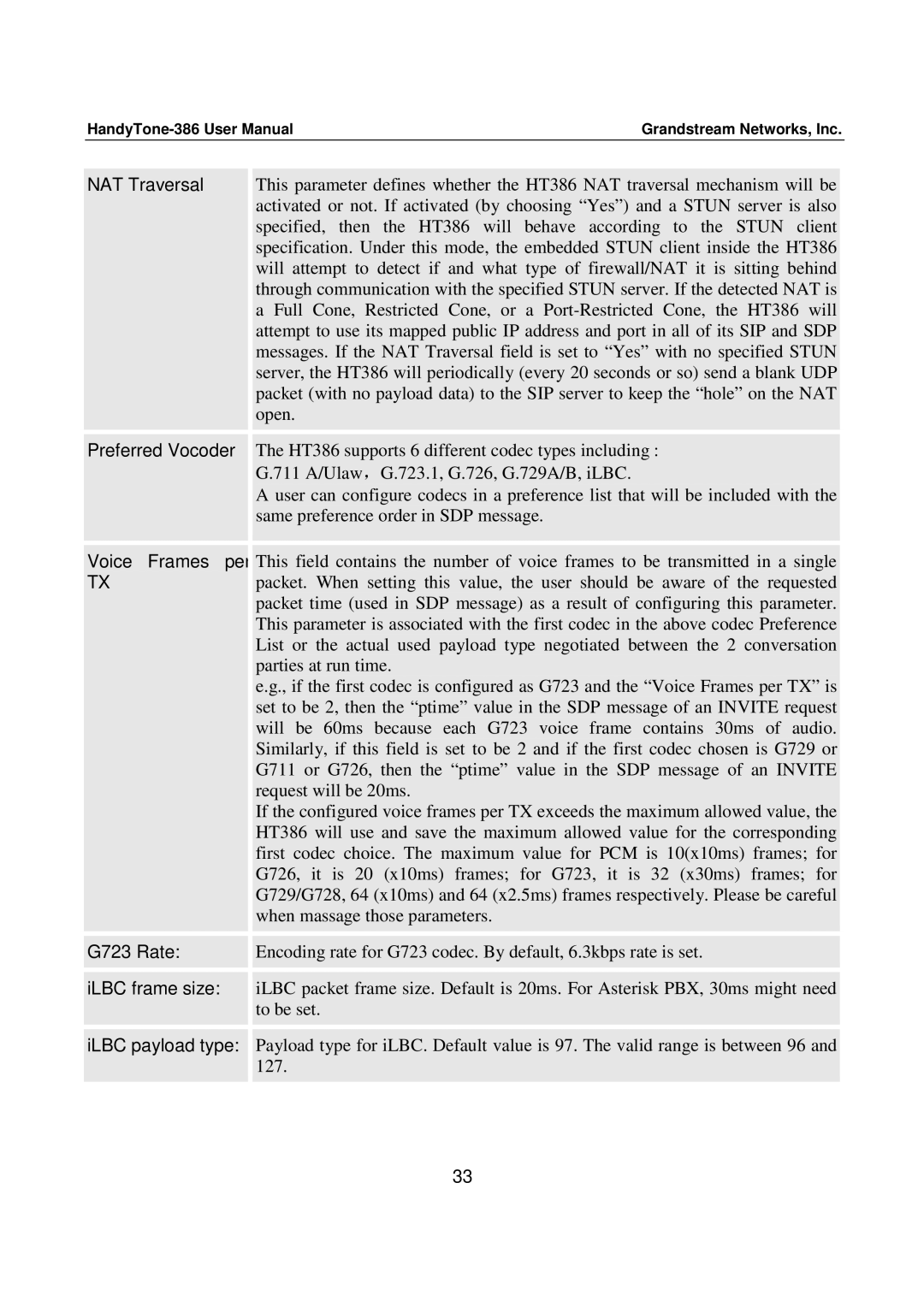
| Grandstream Networks, Inc. | ||||
|
|
|
|
| |
| NAT Traversal |
| This parameter defines whether the HT386 NAT traversal mechanism will be |
| |
|
|
| activated or not. If activated (by choosing “Yes”) and a STUN server is also |
| |
|
|
| specified, then the HT386 will behave according to the STUN client |
| |
|
|
| specification. Under this mode, the embedded STUN client inside the HT386 |
| |
|
|
| will attempt to detect if and what type of firewall/NAT it is sitting behind |
| |
|
|
| through communication with the specified STUN server. If the detected NAT is |
| |
|
|
| a Full Cone, Restricted Cone, or a |
| |
|
|
| attempt to use its mapped public IP address and port in all of its SIP and SDP |
| |
|
|
| messages. If the NAT Traversal field is set to “Yes” with no specified STUN |
| |
|
|
| server, the HT386 will periodically (every 20 seconds or so) send a blank UDP |
| |
|
|
| packet (with no payload data) to the SIP server to keep the “hole” on the NAT |
| |
|
|
| open. |
|
|
|
|
|
|
|
|
|
|
|
| ||
| Preferred Vocoder |
| The HT386 supports 6 different codec types including : |
| |
|
|
| G.711 A/Ulaw,G.723.1, G.726, G.729A/B, iLBC. |
|
|
|
|
| A user can configure codecs in a preference list that will be included with the |
| |
|
|
| same preference order in SDP message. |
|
|
|
|
|
|
|
|
|
|
|
|
|
|
|
|
|
| ||
| Voice Frames per |
| This field contains the number of voice frames to be transmitted in a single |
| |
| TX |
| packet. When setting this value, the user should be aware of the requested |
| |
|
|
| packet time (used in SDP message) as a result of configuring this parameter. |
| |
|
|
| This parameter is associated with the first codec in the above codec Preference |
| |
|
|
| List or the actual used payload type negotiated between the 2 conversation |
| |
|
|
| parties at run time. |
|
|
|
|
| e.g., if the first codec is configured as G723 and the “Voice Frames per TX” is |
| |
|
|
| set to be 2, then the “ptime” value in the SDP message of an INVITE request |
| |
|
|
| will be 60ms because each G723 voice frame contains 30ms of audio. |
| |
|
|
| Similarly, if this field is set to be 2 and if the first codec chosen is G729 or |
| |
|
|
| G711 or G726, then the “ptime” value in the SDP message of an INVITE |
| |
|
|
| request will be 20ms. |
|
|
|
|
| If the configured voice frames per TX exceeds the maximum allowed value, the |
| |
|
|
| HT386 will use and save the maximum allowed value for the corresponding |
| |
|
|
| first codec choice. The maximum value for PCM is 10(x10ms) frames; for |
| |
|
|
| G726, it is 20 (x10ms) frames; for G723, it is 32 (x30ms) frames; for |
| |
|
|
| G729/G728, 64 (x10ms) and 64 (x2.5ms) frames respectively. Please be careful |
| |
|
|
| when massage those parameters. |
|
|
|
|
|
|
|
|
|
|
|
| ||
| G723 Rate: |
| Encoding rate for G723 codec. By default, 6.3kbps rate is set. |
| |
|
|
|
|
|
|
|
|
|
| ||
| iLBC frame size: |
| iLBC packet frame size. Default is 20ms. For Asterisk PBX, 30ms might need |
| |
|
|
| to be set. |
|
|
|
|
|
|
|
|
|
|
|
| ||
| iLBC payload type: |
| Payload type for iLBC. Default value is 97. The valid range is between 96 and |
| |
|
|
| 127. |
|
|
|
|
|
|
|
|
33
